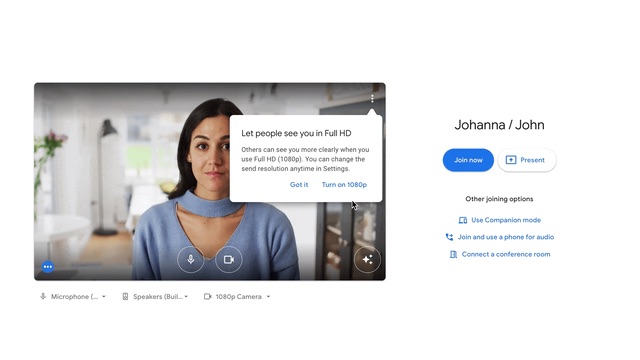Google’s online video conferencing platform is finally getting improved video quality, years after workers turned to Meet for their virtual catchups and brainstorming sessions.
The announcement that Google Meet will now be available in 1080p for some customers has been a long time coming, despite many of its rival companies already offering improved video quality.
Up until now, the service has supported a maximum of 720p as well as a more bandwidth-friendly 360p. Full HD will now be available for certain paying customers in an effort to make your video calls more lifelike.
Google Meet 1080p HD calls
The company detailed some of the requirements in an announcement (opens in new tab) about the update:
“This resolution is available on the web when using a computer with a 1080p camera and enough computing power in meetings with two participants.”
Even so, 720p will be the default setting and users will have to enable 1080p Full HD quality either from a popup at the start of a meeting or deeper in settings. Insufficient bandwidth will also throttle (and reduce) the video quality, though this is unlikely to be a limiting factor for most users.
Some of Google Workspace’s higher-end tiers will be the first to benefit from 1080p, including Business Standard/Plus, Enterprise Starter/Standard/Plus, the Teaching and Learning Upgrade, Education Plus, Enterprise Essentials, and Frontline.
By mid-May, all of the above plans should have access to the improvements, but lower-end tiers and personal customers will have to make do with 720p’s inferior quality for the time being, though it’s worth noting that the Full HD upgrade is also rolling out to Google One customers subscribing to the 2TB plan ($9.99 per month).
More information is available on the Google support page (opens in new tab).
Personal video callers who prefer Apple’s ecosystem may already be familiar with high-quality streaming, because FaceTime has supported 1080p on eligible devices over Wi-Fi and 5G networks for several years.
Both Microsoft Teams and Zoom also support 1080p in certain scenarios, though no platforms have yet pushed the boundaries to 4K support for regular video calling, despite the technology’s growing popularity and integral nature to work and home lives.





